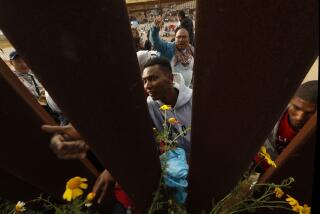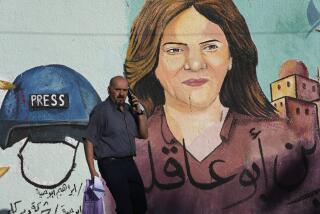On the Media: War photographers change their focus
Journalists take it as gospel that they have no higher calling than chronicling human suffering, particularly in the world’s war zones. But sometimes even an article of faith can be sorely tested.
With a death of two beloved photojournalists this week in an apparent mortar attack in Libya, a scrim of sadness and doubt fell around the cadre of shooters who rush headlong to the world’s trouble spots. The seemingly invincible Tim Hetherington and Chris Hondros were suddenly gone.
Some photographers pulled back from their work. Others vowed they would stay in the game but change their personal rules of engagement. Many revisited their worst misgiving — that no matter how many times they risk their lives, much of the public can’t be bothered with misery in far-off places.
I have talked a lot over the years to war photographers about their work. But I had to wonder this week when it becomes too much. In several interviews, some of the best visual artists of this generation talked about how they realized it was time to step away. They’re still focused on conflict but in different ways.
Corinne Dufka spent more than a decade taking pictures of 17 armed conflicts. She won many of the top awards in the profession while working for Reuters on three continents.
Dufka said she felt gut-punched when she got the news about the comrades killed in Libya, including Hetherington, a friend. “No matter how much you plan and how careful you are, there is just the question of bad luck,” said Dufka, 52, who now works for Human Rights Watch in Senegal. “This has happened too many times — a phone call like this, a friend has been killed. Every time the feeling is just a tremendous sense of loss.”
In the heart of her career, she would not have imagined leaving the thrilling and fulfilling work. But that changed overnight in 1998, when the story she missed made her realize she had gotten in too deep.
It happened when extremists bombed the U.S. Embassy in Kenya. Dufka had gone elsewhere on assignment just before the attack. She felt crestfallen, missing the disaster. Only a few days later, when she saw the terrible images of maimed and blinded civilians on cable TV, did she recognize how her competitive juices had overwhelmed her compassion.
“I realized I was far more upset about missing the story than about what happened to these people,” Dufka told me. “I realized the process was dehumanizing — the pressure, the competition, and the cumulative emotional cost of seeing all that I had seen. At that moment I knew that I was going to get out of the profession.” A few months later, she did.
Her work now focuses on relieving oppression in Western Africa, where she sometimes briefs photographers on where to find a story.
Ashley Gilbertson, one of the most persistent chroniclers of Iraq, said a series of tragedies pushed him away from the war that had been his passion, even obsession.
The first major trauma came during the U.S. assault on Fallouja in 2004. Gilbertson, an Australian native, was working for the New York Times and embedded with a Marine unit. Near the end of the hellacious battle, he wanted to get a picture of an insurgent who he knew had been killed in a nearby minaret.
Gilbertson wanted the picture to show how the enemy had fought in part from the holy sanctuaries. He planned to make the short trek alone, but a Marine captain insisted he take a protective patrol. Gilbertson did not want to miss the picture, so he agreed.
Forging ahead of the photographer up a stairwell, Lance Cpl. William Miller was shot and killed. Until that moment, the full presence of death had escaped Gilbertson. “I feel like I was a young idiot, who felt this would always happen to someone else,” he said. He carries the burden of knowing a young man died helping him try for a picture. “I think,” he said, “I grew up then.”
Many ghastly deaths would follow, including a soldier blown up before his eyes and a Sunni woman killed by extremists, just after what seemed like her moment of triumph — U.S. troops returning her to her home after it had been seized.
“Standing there at her funeral,” Gilbertson said, “I thought nothing is going to bring her back. It all just became too much. I felt like I wasn’t helping anymore. Readers didn’t seem to be engaging. I felt like I had to find a different way to do this.”
He and Hondros sat on a panel at NYU just last December. They talked about post-traumatic stress they suffered and how more needed to be done to help both soldiers and journalists cope. The freelancer, now 33, gained another reason to avoid danger with the birth of his son two years ago.
Now he does his best to record the impact of war from the home front. His series “Bedrooms of the Fallen” consists of solemn black-and-white photos of the homes of dead service members. He hopes the pictures make the audience really see the lives that have gone away.
The deaths of Hondros and Hetherington so profoundly troubled Carolyn Cole, the Los Angeles Times’ stalwart chronicler of danger zones, that she left an assignment and returned home to New York.
Cole recalled that it was Hondros who helped her find her way to the front line in Liberia in 2003. She would win a Pulitzer Prize for feature photography for her pictures of the civil war. Hondros would be a runner-up for spot news. More importantly, they helped bring world attention to an ugly conflict that had gotten little notice in the West. The two worked together many times after that.
Even before the deaths, Cole had begun to recalibrate. She doesn’t plan to be at the point of the attack, as she has many times over the last dozen years. She will not embed with military units anymore, she said, because “you are taking the position that would otherwise be a soldier carrying a gun, so you are endangering the soldiers around you.”
She has no plan to step away from the trouble zones entirely. Speaking for many of her colleagues, she said: “There are still important stories to be told of the human toll inflicted by war.”
Still, choices have to be made. Carol Guzy, the four-time Pulitzer Prize winner (most recently this week) who works for the Washington Post, “crashed and burned” after many years in disaster zones. She then spent nearly a decade avoiding those stories while she worked on other things and got her life in order before returning to Haiti last year to cover the earthquake.
In the old days, Guzy’s personal life always came second to her work. But now her mother has end-stage Alzheimer’s disease. She doesn’t plan to venture far from home soon.
“There is always another story,” Guzy said, “but I only have one mother.”
Twitter: latimesrainey
More to Read
The biggest entertainment stories
Get our big stories about Hollywood, film, television, music, arts, culture and more right in your inbox as soon as they publish.
You may occasionally receive promotional content from the Los Angeles Times.







